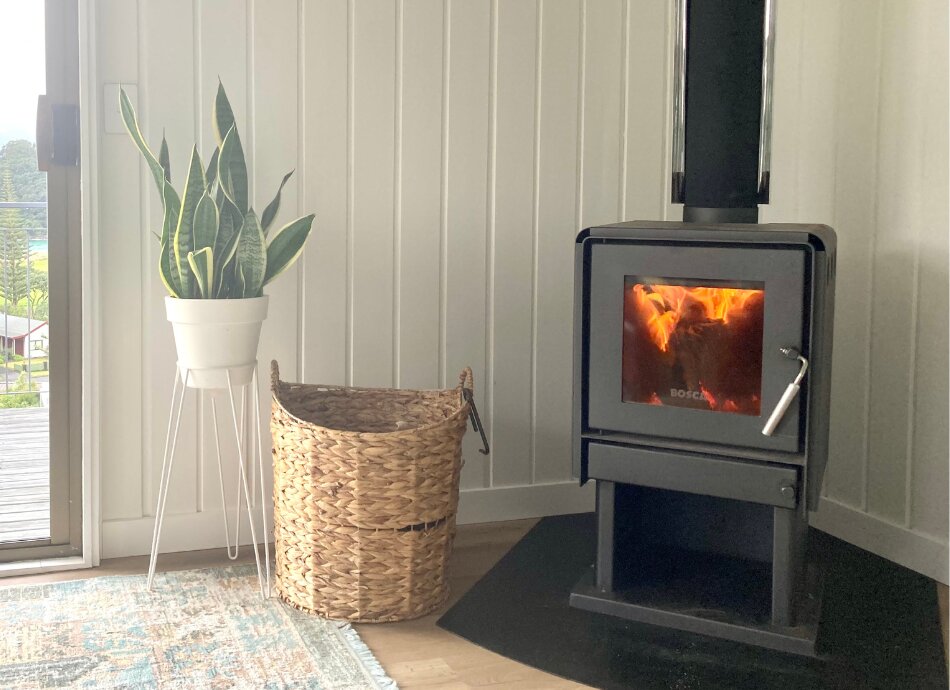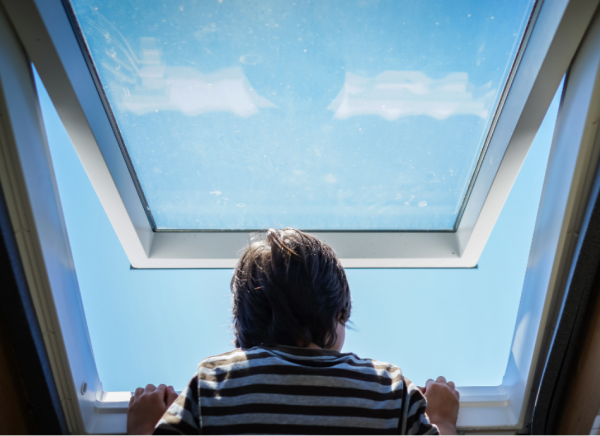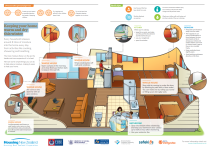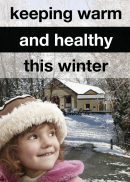Wishing everyone happy holidays and a joyful New Year from the Healthify team. Don't forget to Slip, Slop, Slap and Wrap!
How to keep your home warm in winter
Lock out winter cold and mould without breaking the bank
Key points about keeping your home warm on a budget
- A warm and dry home can help keep you and your whānau healthy over winter, but for some people the cost of having a cosy house might break the bank.
- Many homes in Aotearoa New Zealand are damp, cold and unhealthy.
- A cold and damp home can increase the risk of respiratory illnesses.
- Damp, draughty and poorly insulated homes are more expensive to heat.

1. Do a healthy home check
A healthy home check is an assessment of your home to see if it can be improved in terms of:
- ventilation and insulation
- efficiency of heating, hot water and lighting
- whether rental homes meet the required standard for New Zealand healthy homes.
You might be able to do a check yourself, this checklist for landlords(external link) gives you an idea of what to check and what's needed for rental properties. Some regions offer free assessments, read more about in-home assessments(external link).
2. Insulate your house
Insulation in the roof and under the floor keeps your house warm and dry in winter, but it’s expensive and may not be an option if you’re renting or on a budget.
If you’re on a low income, you may be able to get financial help for home insulation through Health New Zealand's Healthy Homes initiative(external link) (read more below). Some local or regional councils offer insulation deals and the Winter Energy Payment(external link) is available for some people. Insulation is also now compulsory in all rental homes.(external link)
If you don't have insulation, there are other ways you can insulate to help make your home warmer:
- Window films – these kits have a clear plastic film that sticks to your window framing and acts like double-glazing.
- Bubble wrap – added to your windows, bubble wrap provides an extra layer that helps insulate your home against the cold outside air.
- If you have a wooden, tiled or lino floor, add a large rug to cover as much of it as possible. Check Trade Me or Marketplace for lower-cost options.
- Some carpeting companies put their offcuts out for people to take away free of charge. Some of these may be large enough to make a rug from.

Image credit: Canva
3. It's curtains for cold
Having snug-fitting curtains helps keep your house warm. Floor length curtains keep the heat in better than shorter ones. Adding a rolled-up towel on top of your curtain track also stops warm air escaping behind the curtain.
The heat from the sun is free, so make sure you open your curtains in the morning to let the sun’s heat in and close them just before sunset to keep the cold out.
If you don't have curtains you could try a curtain bank, or pinning a blanket up will help to stop the heat escaping.
Curtain banks
If you don’t have curtains, there are several curtain banks that provide good quality, second hand curtains. If you're in Christchurch, Ashburton, Kaikoura or the West Coast you can apply for curtains from the Community Action Agency Charitable Trust(external link).
Red Cross NZ also has curtain banks in some areas. If you live in Tauranga, Whakatāne, Gisborne, Napier, Manawatū-Whanganui and Invercargill, you may be able to get free curtains from one of their curtain banks. Learn how to get warm curtains.(external link)
4. Draught-proof windows and doors
Check there aren’t any draughts coming in through any windows or doors, as this will make your house cold.
Tighten window catches to make sure they close properly, seal any gaps around windows or doors with an appropriate sealant, or strips.
A draught stopper across the bottom of a door (or a rolled up dry towel) helps keep the cold out. Other options include a pool noodle that’s been cut so it fits snugly on both sides of the door, or self-adhesive brush strips. Draught excluder strips are available from hardware shops.
You could make your own draught excluder for under doors by using the leg of old jeans, an old pair of tights or old woolly jumper sleeves. Stuff with newspaper or old clothing.
5. Reduce condensation
Condensation, or water that’s collected on windows and walls, makes your home damp and can cause mould to grow. A damp house is also more expensive to heat. To reduce dampness in your home:
- put lids on pots when cooking
- use an extractor fan in the kitchen and bathroom or open a window
- close the bathroom door while showering
- dry your clothes outside (or in a garage or carport).
If you do have condensation, wipe it off each morning with a towel.
6. Get a good heater
Electric heaters are cheap to buy and safe to use. Get a heater that's the right size for the room you're heating. A heat pump with a thermostat is also a good option as it keeps the cost down. Keep doors closed to rooms that aren't in use.
If you're not going to use your open fire, put something across the front of it (eg, a plywood sheet or an old real estate sign cut to size) to stop warm air escaping up the chimney.
Important information about unflued and portable indoor gas heaters.An unflued gas heater is a heater that burns gas for warmth but doesn't have a pipe to vent the fumes outside. They come in different styles, eg, portable ones that plug into your gas line or bigger ones mounted on the wall. Patio heaters are another type of unflued gas heater, that should never be used inside the house. Unflued indoor gas heaters release dangerous toxins (eg, nitrogen dioxide and carbon monoxide) that can harm your health. They also produce water vapour that can also affect your health by increasing the growth of moulds and dust mites. There are things you can do to protect your health if you have an unflued gas heater. Read 'What should I do if I have an unflued gas heater?'(external link) at Worksafe NZ. |
Don't forget your smoke alarms!
It's very important to fit your house with working smoke alarms. These can be bought cheaply at most supermarkets and hardware stores. You should test them a few times each year (daylight savings is a good time) to make sure they're still working. Most have batteries that you can replace. If you need help, Fire and Emergency NZ offer free Home Fire Safety Visits(external link) to people, family and whānau who require fire safety advice. They can check smoke alarms and provide advice on where they should be installed and how they should be maintained. They can also install alarms that you've bought.
7. Move furniture
Where you have your furniture in your room can make a difference to how easy it is to heat. It may feel good to sit close to your heater or fire, but your furniture can block the heat from spreading, which means it will take longer for the room to heat up.
8. Air your house and let the sunshine in
Make sure you air your house out, even in the colder months. Open the doors and windows on fine days and let the fresh air in to help dry out your home and reduce mould. Sunshine is free and a great way to keep your home drier. If you have trees blocking the sunshine from reaching your house, trim them back to let more light through. If you are renting, ask your landlord first.

Image credit: Canva
9. Get rid of mould
Mould loves to grow in damp and wet places and can cause health problems. Almost half of all homes in Aotearoa New Zealand have mould issues. If you see mould, get rid of it as soon as possible. You can use a bleach solution (2 teaspoons of bleach to 1 litre of water) or white vinegar (without any added water) to remove it.
What is it?
The aim of the Healthy Homes Initiative (HHI) is to increase the number of children and their whānau/families living in warm, dry, and healthy homes and then to improve their health and wellbeing, and reduce the number of hospitalisations due to housing problems.
The HHI identifies eligible families, working with them to carry out a comprehensive housing assessment and make an individualised action plan to create a warmer, drier, healthier home.
Eligible people include:
- pregnant people
- low-income families with children up to 5 years of age who’ve been hospitalised with a specified housing-related condition
- families who are receiving a benefit.
Families are then helped to get the interventions they need to create a better living environment, especially for their children.
Interventions given to these families include help with:
- accessing insulation
- curtains
- beds and bedding
- minor repairs
- floor coverings
- ventilation
- heating sources
- full and correct entitlement assessments through Work and Income
- support with power bills
- finding alternative accommodation as needed.
The scheme is currently available throughout the North Island and in some areas of the South Island. It is gradually being extended to cover all of Aotearoa New Zealand. Find out if you're eligible to take part in the Healthy Homes Initiative.(external link)
Outcomes
HHI providers have seen over 39,000 tamariki and over 135,000 whānau since the initiative started in 2013. Most people referred have been Māori and Pacific people.
A study was done in 2022 looking at outcomes for referred whānau 3 years after they were referred to the HHI and after all the interventions (eg, beds, bedding, curtains, heating, insulation, education, support to find alternative accommodation) had been completed.
After the interventions the following improvements were found:
- Hospitalisations: The number of hospitalisations per person was reduced by 19.8%, or 9,744.58 per year, and the remaining hospitalisations were less severe
- Education: After the HHI intervention there was an increase in school attendance with 3% fewer absences than before
- Income: After the HHI intervention, adults aged 24 to 64 were on 9% less benefits and were 4% more likely to be employed.
Read more about the Healthy Homes Initiative(external link) and the study report.(external link)
Well Homes is a free service that supports whānau in the greater Wellington region to live in a warm, dry, safe, and healthy home. Its services include:
- Resources – bedding, draft stoppers or tape, heaters, mould cleaning starter kits, condensation window cleaner and education.
- Advocacy – minor repairs, Ministry of Social Development and Work and Income assistance, social housing support.
- Referrals – curtain bank, insulation, heat pumps, fire service, and other health and social services.
Who does Well Homes help?
Get in touch if you:
- have a low income, or you're eligible for a Community Services Card (CSC)
- have a housing related health issue, or you're pregnant or a new parent
- live in the greater Wellington region.
Even if you don't meet these criteria, you should still get in touch with Well Homes(external link) as they can link you with other housing services for your situation (such as Warm Fuzzies, Eco Design Advisors).
Find out more at Well Homes(external link).
Here are some tips that won't break the bank on how to keep your home warm and dry in winter. Warm, dry homes help keep you and your whānau healthy.
Video: Keep your house warm and dry this winter
This video may take a few moments to load.
(National Public Health Service – Northern Region, NZ, 2016)
Warmer, drier homes video series
Click the link to watch this series in Samoan(external link) or Tongan(external link).
Part 1: Key tips for a warmer, drier home – sleeping (English)
Create as much space as possible between the heads of sleeping children.
(Ministry of Health, NZ, 2016)
Part 1: Sleeping te reo Māori(external link)
Part 2: Curtains English(external link), te reo Māori(external link)
Part 3: Heating English(external link), te reo Māori(external link)
Part 4: Condensation English(external link), te reo Māori(external link)
Part 5: Windows English(external link), te reo Māori(external link)
Part 6: Steam English(external link), te reo Māori(external link)
Part 7: Draughts English(external link), te reo Māori(external link)
Part 8: Mould English(external link), te reo Māori(external link)
Part 9: Washing English(external link), te reo Māori(external link)
Video: Healthy homes a Kiwi dream – episode 1
The first in a documentary series from Asthma NZ.
(Asthma New Zealand, 2021)
Get warm curtains(external link) Red Cross, NZ
Current insulation and heating subsidies and discounts(external link) (Canterbury) Community Energy Action, NZ
Unflued gas heaters and your health(external link) Worksafe NZ
Home fire safety visits(external link) Fire and Emergency NZ
Healthy Homes Initiative – three year outcomes evaluation(external link) Health New Zealand | Te Whatu Ora, NZ, 2022
Well Homes(external link) Tu Kotahi Māori Asthma Trust, NZ
Warmer Kiwi homes(external link) – covers up to 90% of the costs to purchase and install insulation and up to 80% off an efficient heater. To be eligible you must:
- Own and live in a home built before 2008.
- You (the owner) have either a Community Services Card, SuperGold Combo Card or live in an area identified as low-income.
Check if you are eligible with EECA(external link) (a NZ Government business that encourages the use of sustainable energy in Aotearoa New Zealand.)
Brochures
Keeping your home warm and dry this winter(external link) Housing New Zealand
Winter energy booklet(external link) Ministry of Social Development, NZ
References
- Healthy homes initiative(external link) Health New Zealand | Te Whatu Ora
- Types of heaters(external link) Gen Less, NZ
- Insulation in rental properties(external link) Tenancy Services, NZ
- A renter's guide to a warmer home(external link) Consumer, NZ
- Renter's guide – dealing with mould(external link) Consumer, NZ
- Do a healthy home check(external link) Gen Less, NZ
- Blocking draughts(external link) Gen Less, NZ
- Unflued gas heaters and your health(external link) Worksafe NZ, 2016
- Keeping warm and healthy this winter(external link) Ministry of Social Development, NZ
Brochures

Keeping your home warm and dry this winter
Housing New Zealand

Winter energy booklet
Ministry of Social Development, NZ

Healthy Homes Initiative
Health New Zealand | Te Whatu Ora, NZ, 2022
Credits: Healthify editorial team. Healthify is brought to you by Health Navigator Charitable Trust.
Reviewed by: Healthify editorial team
Last reviewed:
Page last updated:





